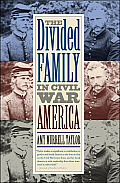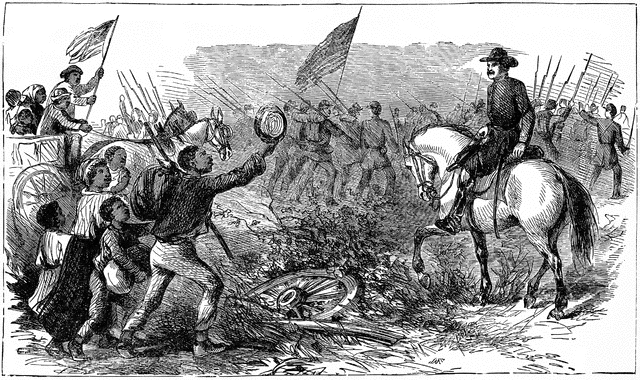“The Scholars Speak”: Civil War and Reconstruction
 Today’s scholar is Professor Amy Murrell Taylor, professor of history at the University of Albany. She is the author of the marvelous book The Divided Family in Civil War America (2005) and a co-editor (with Michael Perman) of Major Problems in the Civil War and Reconstruction.
Today’s scholar is Professor Amy Murrell Taylor, professor of history at the University of Albany. She is the author of the marvelous book The Divided Family in Civil War America (2005) and a co-editor (with Michael Perman) of Major Problems in the Civil War and Reconstruction.
1. Ever since the Civil War began, Americans have been fascinated by “what caused” it. How do the scholars and scholarly debates in Major Problems in the Civil War and Reconstruction present this debate?
We present this debate by suggesting that it is no longer a “debate” at all. To ask “what caused” the Civil War is usually to ask if it was caused by slavery, and the answer to that, my co-editor Michael Perman and I firmly believe, is a resounding yes. Of course, this is not the answer that some Americans still prefer, and quite a few of my students last semester—here in New York, I might add—came into my course thinking that slavery was not really the cause of the Civil War but something that was thrown into the mix somewhere down the line. But the vast scholarly literature on the coming of the war over the last couple decades keeps coming back to this answer, so it would have been out of date to present it as an open question.
Our Major Problems volume therefore builds on the premise that slavery caused the Civil War and then considers the next logical question: how did slavery cause the war? It may be that part of the hesitation about – or denial of – slavery’s role in the war comes from a basic lack of understanding of exactly how it could become intertwined in the nation’s social, political, and economic development all at once. It is not easy to straighten out this history in one’s mind. But rather than abandon the effort, we encourage students to confront the complex history of slavery’s causation in multiple ways. The second chapter in the volume, “The Slave South,” for example, considers how slavery shaped popular beliefs about the South’s economy and society. To what extent did slavery encourage Americans—then and now—to view the South as a different place? To what extent did the belief in those differences affect their impulse to compromise or go to war? Chapters three, “The Impending Crisis,” and four, “Sectionalism and Secession,” turn next to politics, and specifically, to the way in which slavery entered into and changed the course of politics in the 1840s-1860s. What did leaders North and South think was at stake when they debated the expansion of slavery in the west? What did they fear? How did this debate give rise to distinct political worldviews on either side of the sectional divide? And how did this, in turn, make war seem increasingly necessary and unavoidable?
2. If you had to select one primary document that showed the coming of the Civil War, which would it be and how would you use it in the classroom?
I have actually used all of them, but there is one that, time and again, makes students sit up and take notice: Alexander Stephens’March 1861 address – his so-called “cornerstone” speech. To hear the vice president of the Confederacy state outright that this new nation’s “foundations are laid, its cornerstone rests, upon the great truth that the negro is not equal to the white man; that slavery, subordination to the superior race, is his natural and moral condition,” is quite shocking for some readers. My students don’t expect to hear one of our historical actors talk so explicitly – they expect more formal or indirect 19th century phrasing, I guess – and of course the speech demolishes the notion that slavery was somehow incidental rather than central to the South’s secession. It was its “cornerstone.” (Interestingly, Jefferson Davis didn’t expect to hear Stephens talk so explicitly either and was reportedly dismayed by the vice president’s carelessness in revealing the centrality of slavery.)
I always tell students that the best way to understand the past, or to understand how and why people acted in the way that they did in the past, is to read their words. Here is a set of words that does not distract students with unfamiliar language, and does not beat around the bush, but instead cuts right to the heart of the matter of why the Confederacy came to exist. It pulls away the curtains that students may have thought still obscured the Civil War past. Sure, I’ve had some students who were inclined to be skeptical, who would rather see the speech as the view of one person rather than of the whole, but even this reaction can help elicit a more general discussion perspective and representativeness in our primary sources.
3. What are the next plans for _Major Problems in the Civil War and Reconstruction_?
We would like to publish another volume! And I think the scholarly literature on the Civil War will support a revised volume in the not-too-distant future. It might surprise some people that a single war could generate the thousands of books that it has – and still manage to stimulate more and more books every year. But it does, and right now Civil War scholarship seems to be as healthy and vibrant as ever. I don’t think this has much to do with the current sesquicentennial observance prompting new work, but instead has more to do with some of the dynamics of the field itself. We now have not one but two journals devoted to publishing scholarship in the era – and both are excellent – and this summer the Society of Civil War Historians is about to host its 3rdconference. New trends evident in American history more broadly seem to be making a dent on the war’s literature too, from environmental and public health history to the history of technology, and I can already envision a future volume that would take these new approaches into account.
4. What are you working on now or are there any of your more recent articles or books that would help students more interested in this topic?
I’m working on a book about the mass flight of enslaved men, women, and children during the Civil War–the so-called “contrabands.” It’s a population that is widely known about (see the documents by Benjamin Butler and the American Freedmen’s Inquiry Commission in our volume). But it’s also a population more commonly discussed as a collective–as a powerful force numbering over 500,000–than as individuals. So I am tackling such basic questions as: Who were they? Where did they go? What did they experience on a day-to-day basis while living in Union camps? For a narrow glimpse of this research, students are welcome to consult an article I recently published: “How a Cold Snap in Kentucky Led to Freedom for Thousands: An Environmental Story of Emancipation,” in Stephen Berry, ed., Weirding the War: Stories from the Civil War’s Ragged Edges (Athens: University of Georgia Press, 2011). I should also note that there are other projects about emancipation in the works right now by other historians, so I suspect that this could be yet another topic to be addressed differently in a forthcoming Major Problems volume.



Monday quiz hints will be posted over the weekend; one to start: check out how William Howard Day felt about the United States in 1865
FYI: my colleague and your co-author Michael Perman just taught his last class (!), retiring now so he can work on other projects. Wish him well if you know him.
About the causes of the Civil War you are right, but the question that I find more difficult (even amid the flood of recent scholarship) is: why fight? Certainly all those Irish Catholic draft rioters weren’t fighting to end slavery (when they did eventually fight). So even though the war happened because of slavery, and even though the slave power conspiracy drove many northerners crazy, with John Brown and friends returning the favor for the south, I am always stuck by the question of what drove these hundreds of thousands of men to fight. You know the recent scholarship better than I do, but it seems to move from honor, to union, to slavery. But of course that’s a gross simplification, right?
Kevin raises a great question about Union motivation. I’ve been reading lots and lots of Union diaries. Of course, James McPherson long ago said they fought for “cause and comrade” and the “cause” was usually the Union, but could also be antislavery, etc. In lots of the letters I’m reading, the soldiers never say why they joined, they just join, but the reasons for Confederates are often complicated too. I’ve been reading some Confederates from Texas who hate everything about Arkansas and Mississippi, and yet they go there to fight (and they only seem enraged when the Emancipation Proclamation goes into effect).
Anyway, this is just me ruminating on what I’m reading now. For my students, who should be reading from Major Problems, they should be sure to know which woman there pushed for women’s suffrage and which woman discussed Klan attacks. That may be on the quiz.
oh, and I would know something about oaths and military districts from Hist and Matt’s lecture … just saying for quiz sake